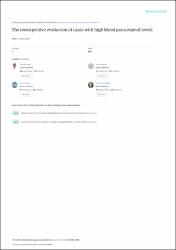| dc.contributor.author | Kandiş, Hayati | |
| dc.contributor.author | Bilir, Özlem | |
| dc.contributor.author | Çolak, Şahin | |
| dc.contributor.author | Sarıtaş, Ayhan | |
| dc.contributor.author | Şenel, Ahmet | |
| dc.contributor.author | Koşargelir, Mehmet | |
| dc.contributor.author | Afacan, Mustafa Ahmet | |
| dc.contributor.author | Baltacı, Davut | |
| dc.contributor.author | Kara, İsmail Hamdi | |
| dc.date.accessioned | 2020-12-19T19:58:46Z | |
| dc.date.available | 2020-12-19T19:58:46Z | |
| dc.date.issued | 2015 | |
| dc.identifier.citation | Kandis, H., Bilir, O., Colak, S., Saritas, A., Senel, A., Kosargelir, M., Afacan, M.A. ve diğerleri (2015). The retrospective evaluation of cases with high blood paracetamol levels. Acta Medica Mediterranea, 31(5), 987-993. | en_US |
| dc.identifier.issn | 0393-6384 | |
| dc.identifier.issn | 2283-9720 | |
| dc.identifier.uri | https://hdl.handle.net/11436/3003 | |
| dc.description | KARA, ISMAIL HAMDI/0000-0003-2022-1882; KARA, ISMAIL HAMDI/0000-0003-2022-1882 | en_US |
| dc.description | WOS: 000372137700009 | en_US |
| dc.description.abstract | Introduction: the aim of the study is to compare laboratory parameters and clinical outcomes of the patients taking paracetamol only and those of the patients using other medications in addition to paracetamol. Material and method: 471 cases whose ages were 15 or over, and who had a history of paracetamol intake as a single drug or in addition to other medications, and had high serum paracetamol levels, admitted to our emergency department (ED) in a 24-month period. Patients were divided into 3 groups according to Modified Rumack-Matthew nomogram and whether they took paracetamol only or together with other drugs: Paracetamol levels higher than toxic level (Group 1), lower than toxic level and using only paracetamol (Group 2), lower than toxic level and using other medications in addition to paracetamol (Group 3). in all cases, alanine amino transferase, aspartate aminotransferase, platelet counts and INR values were retrospectively recorded. Cases were evaluated in terms of the rates of discharge from the ED, hospitalization and mortality. Results: Eighty two of 471 patients were in the Group 1, 264 cases were in the Group 2, and 125 cases were in the Group 3. Forty nine of patients admitted to the ED within-2 hours after drug ingestion. Gastric lavage was performed and activated charcoal was administered in 94% (n=443) of patients presenting to ED in the following 4 hours after ingestion of paracetamol. Only the cases in the Group 1 had a statistically significant difference in ALT, AST, PLT and INR values measured on admission and at the 12th hour 377 cases were discharged after ED observation, and 94 patients were hospitalized. All patients were discharged with full recovery. Conclusion: Determining the treatment protocol by measuring serum paracetamol level shortens the duration of hospital stay, decreases treatment costs and helps avoid unnecessary N-acetylcysteine applications. | en_US |
| dc.language.iso | eng | en_US |
| dc.publisher | Carbone Editore | en_US |
| dc.rights | info:eu-repo/semantics/openAccess | en_US |
| dc.subject | Acetaminophen | en_US |
| dc.subject | Poisoning | en_US |
| dc.subject | Overdose | en_US |
| dc.title | The retrospective evaluation of cases with high blood paracetamol levels | en_US |
| dc.type | article | en_US |
| dc.contributor.department | RTEÜ, Tıp Fakültesi, Cerrahi Tıp Bilimleri Bölümü | en_US |
| dc.contributor.institutionauthor | Bilir, Özlem | |
| dc.identifier.volume | 31 | en_US |
| dc.identifier.issue | 5 | en_US |
| dc.identifier.startpage | 987 | en_US |
| dc.identifier.endpage | 993 | en_US |
| dc.relation.journal | Acta Medica Mediterranea | en_US |
| dc.relation.publicationcategory | Makale - Uluslararası Hakemli Dergi - Kurum Öğretim Elemanı | en_US |


















